Contemporary Art
1/26
There's no tags or description
Looks like no tags are added yet.
Name | Mastery | Learn | Test | Matching | Spaced |
|---|
No study sessions yet.
27 Terms
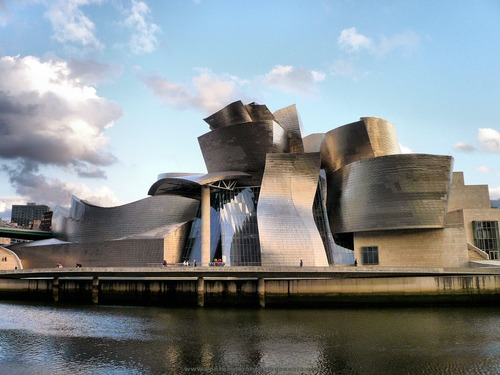
Guggenheim Bilbao Museo:
- Canadian-American architect based in Los Angeles
- swirling forms and shapes mark a contract w/ industrial landscape of Bilbao
- from river side, building resembles a boat, referencing the Bilbao's past as a shipping and commercial center
- curving forms designed by computer software program called Catia
- fixing clips make shallow dent in titanium surface; effect of having a shimmering surface that changes according to atmospheric conditions
- revitalized port area of Bilbao; "Bilbao effect" refers to impact that a museum can have on a local economy
- appearance of asymmetrical exterior w/ outside walls giving no him to interior spaces
- irregular masses of titanium walls
- sweeping curved lines
- called deconstructivist architecture: architecture that seeks to create a seemingly unstable environment w/ unusual spatial arrangements

MAXXI National Museum of XXI Century Arts:
- Iraqi-born, British-based artist
- two museums (MAXXI Art and MAXXI Architecture), a library, auditorium, and cafeteria
- internal spaces covered by glass roof; natural light admitted into interior, filtered by louvered blinds
- walls flow and melt into one another, creating new and dynamic interior spaces
- constantly changing interior/exterior views
- transparent roof, modulate natural light

The Gates:
- Christo Bulgarian born; Jean-Claude of French descent, born in Morocco
- 7503 "gates" of free-hanging saffron colored fabric panels
- framed all pathways in Central Park, New York City
- 16 feet tall gates formed continuous river of color
- covered 23 miles of footpaths
- temporary installation, left for sixteen days
- after exhibition closed, materials recycled

Vietnam Veterans Memorial:
- artist Ohio-born Chinese-American
- V-shaped monument cut into earth w/ 60,000 casualties of Vietnam War listed in order killed or reported missing
- one arm pointed to Lincoln Memorial, other to Washington Monument
- black granite highly reflective surface so that viewers can see themselves in the names of the veterans; black appropriate somber color for memorial
- strongly influenced by Minimalist movement
- contest for memorial design; some backlash when it was revealed Asian person won
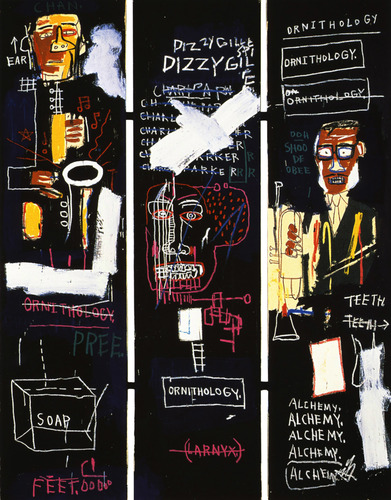
Horn Players:
- artist born in Brooklyn, New York, of Puerto Rican and Haitian parents; rebelled against middle class upbringing he was born into
- some traditional forms: triptych, canvas, oil paint
- modernist expression: influence of graffiti art
- flattened darkened background; flat patches of color; thick lines
- glorifies African-American musicians: salte to Jazz musicians Charlie Parker and DIzzy Gillespie in either wing
- heads seem to float over outlined bodies and dissolve as you go down body
- focus on contrast and juxtaposition, not on balance/scale
- words are those attributed to musicians (ornithology misspelled; reference to Charlie "THe Bird" Parker)

Summer Trees:
- Korean artist using traditional ink on paper
- large vertical lines of various thickness
- subtle tonal variations of ink wash
- one of leaders of "Sumukhwa", a new type of ink paintings 1980s; ink painting traditional form of artistic expression in Korea; this movement revitalizes ink painting in modern context
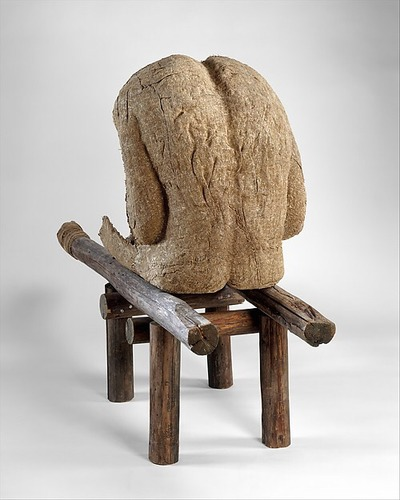
Androgyn III:
- Polish artist
- since 1974, artist makes figures often w/o heads/arms in large groups singly
- figures sit on low stretcher of wooden legs, substituting for human legs
- figure hollowed out, just a shell, hardened fiber casts made from plaster molds
- figure placed to be seen in the round: complete back, the hollow front
- hardened figure has appearance of crinkled human skin set in earth tones
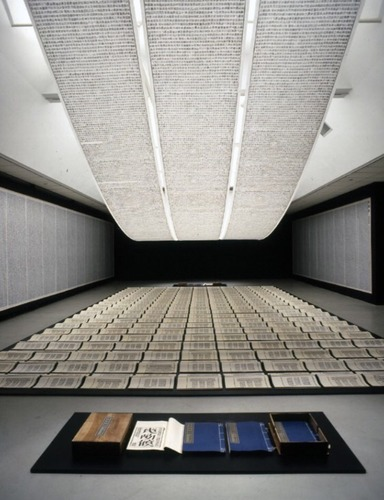
A Book From the Sky
- Chinese-born artist; US resident
- original title: "An Analyzed Reflection of the End of This Century"
- original in National Museum of Fine Arts in Beijing; filled a large exhibition space
- 400 handmade books placed in rows on ground
- one walks beneath fifty printed scrolls, which hang from the ceiling
- uses traditional Asian woodblock techniques
- many of Chinese characters inventions of artist and have no meaning
- artist lost favor w/ Communist government over this work
- criticized as "bourgeois liberation" and it was claimed that its meaninglessness hid secret subversions

Pink Panther:
- Pennsylvania-born artist, working in New York
- work exists as a commentary on celebrity romance, sexuality, commercialism, stereotypes, pop culture, sentimentality
- artificially idealized female form: overly yellow hair, bright red lips, large breasts, pronounced red fingernails; overtly fake look
- life-size
- kitsch
- created permanent reality out of something ephemeral and never meant to be exhibited
- woman is Jayne Mansfield, a popular screen star
- Pink Panther, cartoon character derived from series of American movies
- tender delicacy of panther's gesture
- part of series called "The Banality" at show in Sonnabend Gallery in NY 1988

Untitled (#228), from the History Portrait series:
- New Jersey born, American artist; appears as photographer, subject,costumer, hairdresser, and makeup artist in each work
- works comment on gender, identity, society, and class distinction
- this series sheds a modern light on great masters
- uses old master painting as a starting point, but the works are not derivative
- image explores theme of Judith decapitating Holofernes
- richness of costuming and setting acts as commentary on late 19th century versions of this subject
- richly decorative drapes hang behind figure
- Judith lacks any emotional attachment to the murder that has taken place
- Holofernes appears mask-like, alert, and nearly bloodless
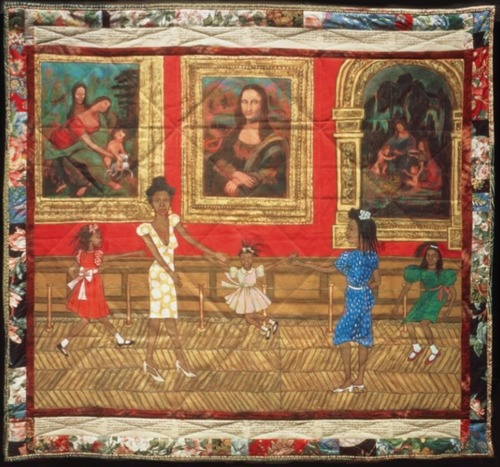
Dancing at the Louvre from the series The French Collection, Part I; #1:
- New York-born African-American artist; uses American slave art form of quilt to create works
- quilts originally meant to be beautiful and useful; works of applied art; seen as traditionally female art form
- combines traditional use of oil paint w/ quilting technique
- these quilts not meant to be placed on beds
- narrative element
- feminist issues dominate
- often figures in Ringgold works act out history that might never have taken place, but artist would have liked to take place
- fictional character named WIllia Marie Simone, who takes her friend and three daughters to Louvre and dances in front of three paintings by Leonardo Da Vinci
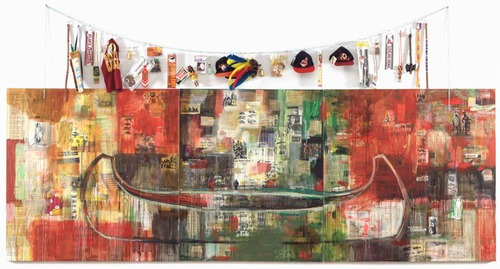
Trade (Gifts for Trading Land with White People):
- member of Salish and Kootenai American Indian tribes of Flathead Nation
- meant as "Quincentenary Non-Celebration" of European occupation of North America; response to 500th anniversary of Columbus's voyage to Americas
- collage elements and abstract expressionist brushwork
- red paint symbolic of shedding of American Indian blood
- newspaper clippings, images of conquest placed over large dominant canoe
- American Indian social issues caused by European occupation stressed: poverty, unemployment, disease, alcoholism
- array of objects sardonically representing Indian culture in eyes of Europeans: sports teams, Indian-style knick knacks like toy tomahawks, dolls, and arrows
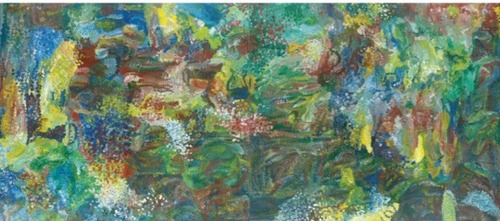
Earth’s Creation:
- Australian aborigine artist
- simulates color and lushness of "green time" in Australia after rains when outback flourishes
- dump dot technique using brush to pound color into canvas and create layers of color and movement
- four panels, eleven meters wide
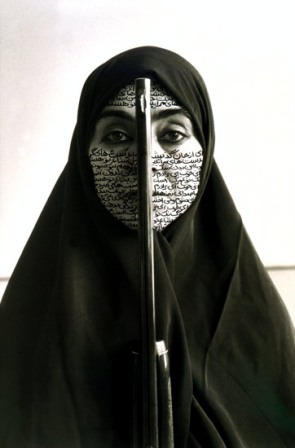
Rebellious Silence, from the Women of Allah series:
- Iranian-born artist, raised in US
- poem on face written in Farsi; expresses piety
- poem by Iranian woman who writes poetry on gender issues
- gun divides body into darker and lighter side; adds note of ominous tension in work
- Westerners view work as expression of female oppression
- Iranians could view work as obedient right-minded woman ready to die defending her faith and customs
- black and white photograph
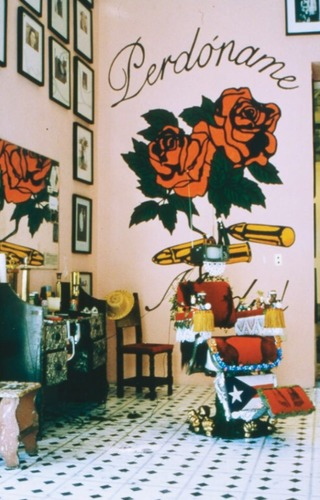
En la barbería no se Llora (No Crying Allowed in the Barbershop):
- Puerto Rican-born artist living in New York
- large installation recreating center of Latino male culture: barbershop
- challenges viewer to question issues of identity, masculinity, culture, attitudes
- interior of barbershop in which "no crying is allowed" -- masculine attribute
- photos of Latino men on walls
- video screens on headrests depict men playing, a baby being circumcised, men crying
- appropriately tacky and grimy setting
- kitsch items used everywhere as symbols of consumer culture

Pisupo Lua Afe (Corned Beef 2000):
- artist born in New Zealand of Samoan, Cook Islands, and Tahitian descent
- interest in Polynesian heritage
- life-size sculpture of bull made from flattened cans of corned beef
- canned corned beef a favorite food in Polynesia; exported from New Zealand
- canned meat (pisupo) given as gifts on special occasions in Polynesia; major contributor to Polynesian obesity
- introduction of canned meat caused fall in traditional cultural skills of fishing, cooking, agriculture
- static sculpture w/ small concealed wheels at feet for ease of movement
- theme of recycling emphasized by reuse of these cans
- two motorized bulls often engage in multi-media performance art called The Challenge
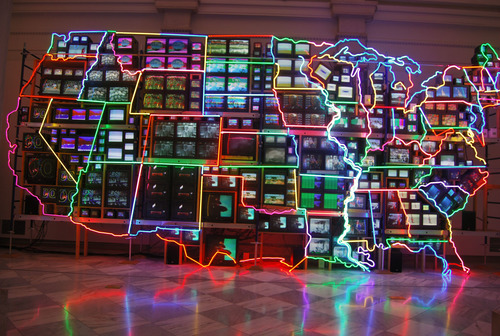
Electronic Superhighway:
- Korean-born artist who lived in New York City; intrigued by maps and travel: neon outlines symbolize multicolored maps for each state; fascination w/ interstate highway system; neon symbolizes motel and restaurant signs
- neon lighting outlines fifty states and District of Columbia (Alaska and Hawaii on side walls)
- each state w/ separate video feed; total of 313 monitors
- camera turned on to spectator and its TV feed appears on one of monitors; turns spectator into participant in artwork

The Crossing:
- born in Queens, New York
- promoted video as an art form
- video installations are total environments
- two channels of color video projections from opposite sides of large dark gallery onto two large back-to-back screens suspended from ceiling and mounted to floor; four channels of amplified stereo sound, four speakers
- two channels of video projected onto 12 foot tall double-sided screen; on one side, figure approaches from long distance; as he stopes, a small flame appears on his feet and spreads rapidly to engulf him in roaring fire; when subsides, man is gone
- on opposite side: when figure stops, stream of water begins to pour on head; quickly turns into raging torrent, inundating the man; when water slows, man is gone
- two video screens: free-standing, double-sided projections
- fire: flames consum figure of man, beginning at his feet
- water: man walks toward viewer and water falls from above
- figures walk in extremely slow motion
- actions repeat again and again
- interested in sense perceptions; same noise plays for both, but seems to fit whichever viewer is watching
- implied cycle of purification and destruction
- evokes eastern and western spiritual traditions: Zen Buddhism, Islamic Sufism, Christian mysticism
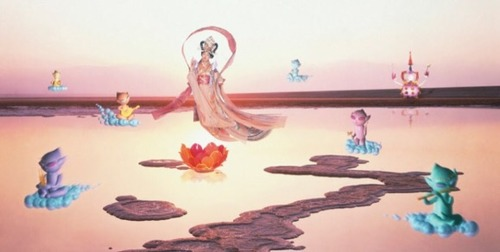
Pure Land:
- Japanese artist; uses creative interpretation of traditional Japanese art forms
- romanticized views of popular culture
- Mori appears as if in a vision in guise of Heian deity Kichijoten, the essence of beauty and harbinger of prosperity and happiness
- holds wish-granting jewel, a nyoi hoju, which has the power to deny evil and fulfill wishes
- jewel symbolizes Buddha's universal mind
- animated figures of lighthearted aliens play musical instruments on clouds
- merging of consumer entertainment fantasies w/ traditional Japanese imagery
- dead sea salty --> Shintoism: salt as purification agent
- Buddhist lotus
- toy in back resembles Tibetan stupa
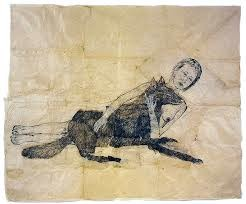
Lying with the Wolf:
- American artist, born in Germany, lives in New York City
- nude female figure; theme of Smith's work is human body
- large wrinkled drawing, pinned to a wall; reminiscent of table cloth or bed sheet
- female strength emphasized in woman lying down w/ wild beast
- wolf seems to be tamed by woman's embrace
- wolf seen as traditionally evil/dangerous symbol, but not here
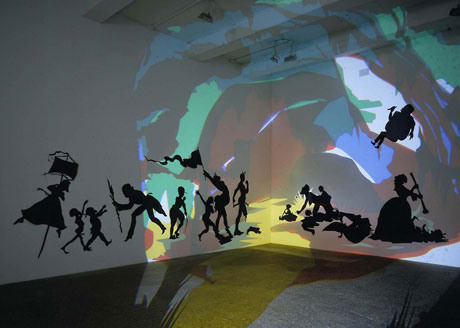
Darkytown Rebellion
- California-born, New York-based, African American artist
- technique: draws images w/ greasy white pencil or soft pastel crayon on large pieces of black paper; cuts paper w/ knife; images adhered to gallery wall w/ wax; traditional silhouette forms; overhead projectors throw colored light onto walls, ceilings, floor; cast shadows of viewer's body that mingle w/ black paper images
- exploration of African-Americans in antebellum South: tennager holds flag that resembles colonial ship sail; one man has leg cut off; woman aborting a child; woman caring for newborns
- viewer interacts w/ work, walking around it, engaging in elements of it; we are part of the history of piece
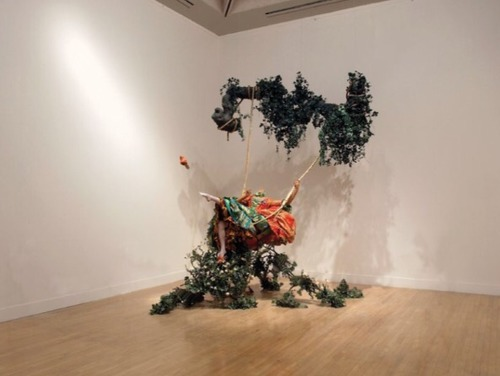
The Swing (after Fragonard):
- artist British born of Nigerian descent; lives and works in London
- life-size headless mannequin; guillotined by French Revolution
- European-style dress made of African print fabric (batik); represents colonialism and relationship between Europe and Africa
- flowering vines cast to floor
- two men in Fragonard painting not included; audience takes place of the men; erotic voyeurism

Old Man’s Cloth:
- artist born in Ghana, spent much of career in Nigeria
- 1000 drink tops joined by wire to form cloth-like hanging
- bottle caps from distillery in Nigeria
- power tools, like chainsaws and welding torches
- converts found materials in new type of media that lies someplace between painting and sculpture
- recycling of found objects
- colorful textured wall hangings; relates to Western African textiles
- combines aesthetic traditions of home country, adopted country, and global art movement of abstract art
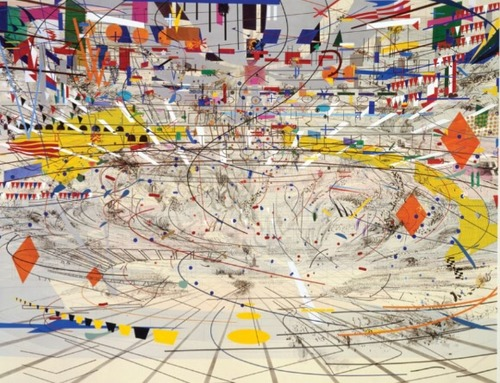
Stadia II:
- born in Ethiopia, lives and works in NYC
- paints large scale paintings
- although paintings done w/ abstract elements, titles allude to meaning
- stylized rendering of stadium architecture
- forms suggest excitement, almost frenzy of competition held in circular space surrounded by international images
- dynamic competition suggested in sweeping lines that create vibrant pulse
- uses multi[layered lines to create animation in work
- sweeping lines to create depth, focus of attention around large central core from which colors, icons, flags, and symbols resonate
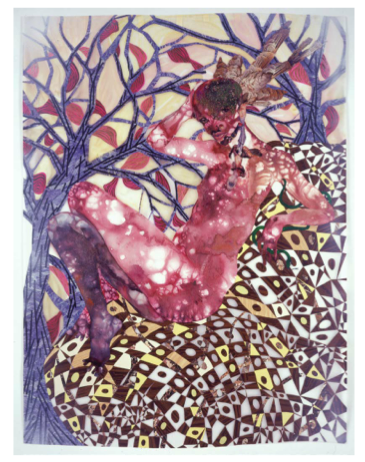
Preying Mantra:
- Kenya-born, New York-based artist
- collaged female figures composed of human, animal, object, and machine parts
- commentary on female persona in art history
- cyborg
- reclines in relaxed position
- green snake interlocks w/ fingers; bird feathers in back of head
- left ear lobe has chicken feet, insect legs, and pinchers
- blotched skin
- ironic twist on praying mantis: suggests religious rituals; mantis means "prophet" in Greek; insects use camouflage; this figure seems camouflaged
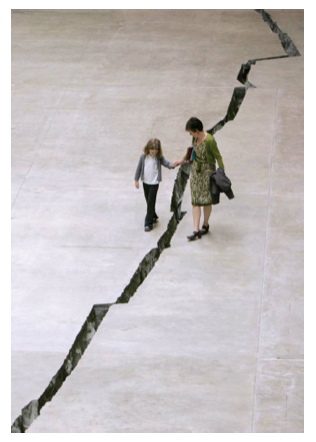
Shibboleth:
- Colombian sculptor
- installation that features large crack that begins as hairline and widens to two feet in depth
- floor of museum opened and a cast of Columbian rock faces inserted
- stresses interaction between sculpture and space
- Shibboleth meant to exclude people from joining a group
- crack emphasizes gap in relationships; reminder of disruption in spaces
- references racism and colonialism; keeping people away or separating them
- installation now sealed, but exists as a scar, commemorates life of underclasses
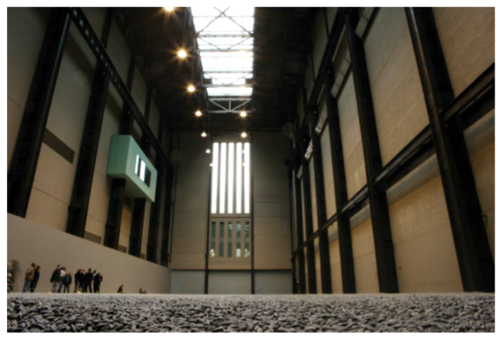
Kui Hua Zi (Sunflower Seeds):
- Chinese artist
- installation containing millions of individually handcrafted ceramic pieces resembling sunflower seeds
- symbolically represent ocean of fathomless depth; each seed made in Jingdezhen, city known for porcelain production Imperial China
- 600 artisans worked for two years, each seed hand-painted
- sunflower seeds eaten as source of food during famine era under Mao Zedong
- ideology of Chairman Mao: he was sun, followers seeds
- originally installation walkable, but raised harmful ceramic dust, viewing then limited to sidelines